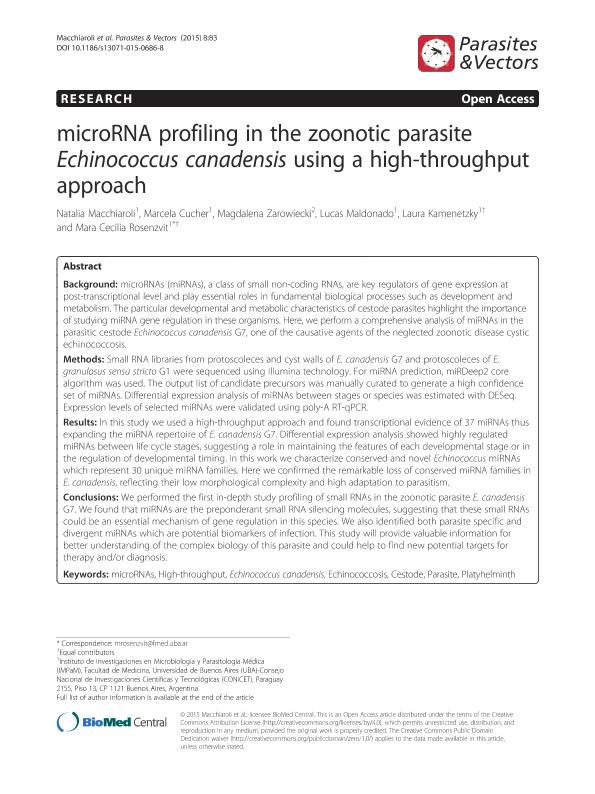Artículo
microRNA profiling in the zoonotic parasite Echinococcus canadensis using a high-throughput approach
Macchiaroli, Natalia ; Cucher, Marcela Alejandra
; Cucher, Marcela Alejandra ; Zarowiecki, M.; Maldonado, Lucas Luciano
; Zarowiecki, M.; Maldonado, Lucas Luciano ; Kamenetzky, Laura
; Kamenetzky, Laura ; Rosenzvit, Mara Cecilia
; Rosenzvit, Mara Cecilia
 ; Cucher, Marcela Alejandra
; Cucher, Marcela Alejandra ; Zarowiecki, M.; Maldonado, Lucas Luciano
; Zarowiecki, M.; Maldonado, Lucas Luciano ; Kamenetzky, Laura
; Kamenetzky, Laura ; Rosenzvit, Mara Cecilia
; Rosenzvit, Mara Cecilia
Fecha de publicación:
02/2015
Editorial:
BioMed Central
Revista:
Parasites and Vectors
ISSN:
1756-3305
Idioma:
Inglés
Tipo de recurso:
Artículo publicado
Clasificación temática:
Resumen
Background: microRNAs (miRNAs), a class of small non-coding RNAs, are key regulators of gene expression at post-transcriptional level and play essential roles in fundamental biological processes such as development and metabolism. The particular developmental and metabolic characteristics of cestode parasites highlight the importance of studying miRNA gene regulation in these organisms. Here, we perform a comprehensive analysis of miRNAs in the parasitic cestode Echinococcus canadensis G7, one of the causative agents of the neglected zoonotic disease cystic echinococcosis. Methods: Small RNA libraries from protoscoleces and cyst walls of E. canadensis G7 and protoscoleces of E. granulosus sensu stricto G1 were sequenced using Illumina technology. For miRNA prediction, miRDeep2 core algorithm was used. The output list of candidate precursors was manually curated to generate a high confidence set of miRNAs. Differential expression analysis of miRNAs between stages or species was estimated with DESeq. Expression levels of selected miRNAs were validated using poly-A RT-qPCR. Results: In this study we used a high-throughput approach and found transcriptional evidence of 37 miRNAs thus expanding the miRNA repertoire of E. canadensis G7. Differential expression analysis showed highly regulated miRNAs between life cycle stages, suggesting a role in maintaining the features of each developmental stage or in the regulation of developmental timing. In this work we characterize conserved and novel Echinococcus miRNAs which represent 30 unique miRNA families. Here we confirmed the remarkable loss of conserved miRNA families in E. canadensis, reflecting their low morphological complexity and high adaptation to parasitism. Conclusions: We performed the first in-depth study profiling of small RNAs in the zoonotic parasite E. canadensis G7. We found that miRNAs are the preponderant small RNA silencing molecules, suggesting that these small RNAs could be an essential mechanism of gene regulation in this species. We also identified both parasite specific and divergent miRNAs which are potential biomarkers of infection. This study will provide valuable information for better understanding of the complex biology of this parasite and could help to find new potential targets for therapy and/or diagnosis.
Palabras clave:
MICRORNAS
,
HIGH-THROUGHPUT
,
ECHINOCOCCUS CANADENSIS
,
ECHINOCOCCOSIS
Archivos asociados
Licencia
Identificadores
Colecciones
Articulos(OCA HOUSSAY)
Articulos de OFICINA DE COORDINACION ADMINISTRATIVA HOUSSAY
Articulos de OFICINA DE COORDINACION ADMINISTRATIVA HOUSSAY
Citación
Macchiaroli, Natalia; Cucher, Marcela Alejandra; Zarowiecki, M.; Maldonado, Lucas Luciano; Kamenetzky, Laura; et al.; microRNA profiling in the zoonotic parasite Echinococcus canadensis using a high-throughput approach; BioMed Central; Parasites and Vectors; 8; 83; 2-2015; 1-17
Compartir
Altmétricas



